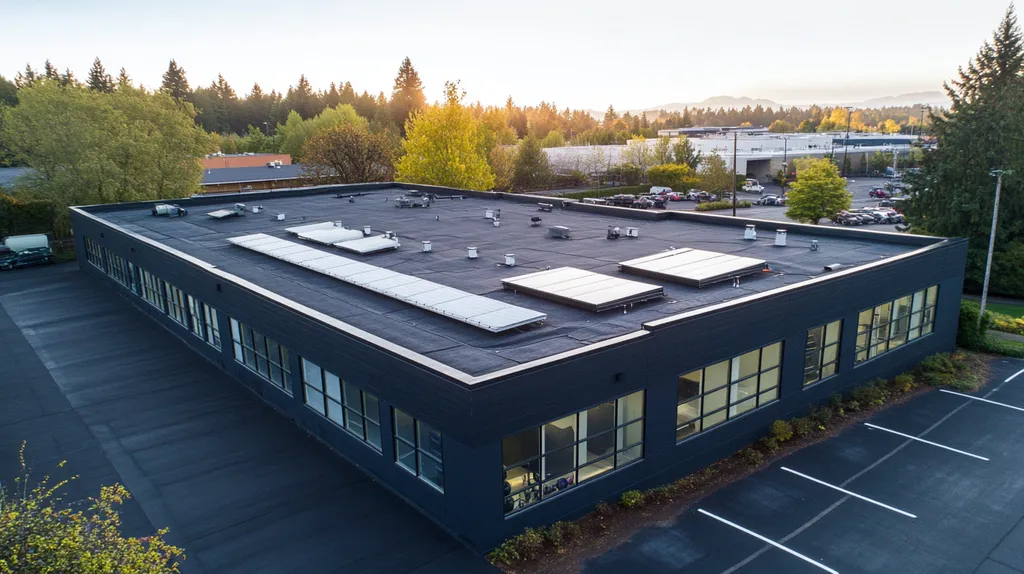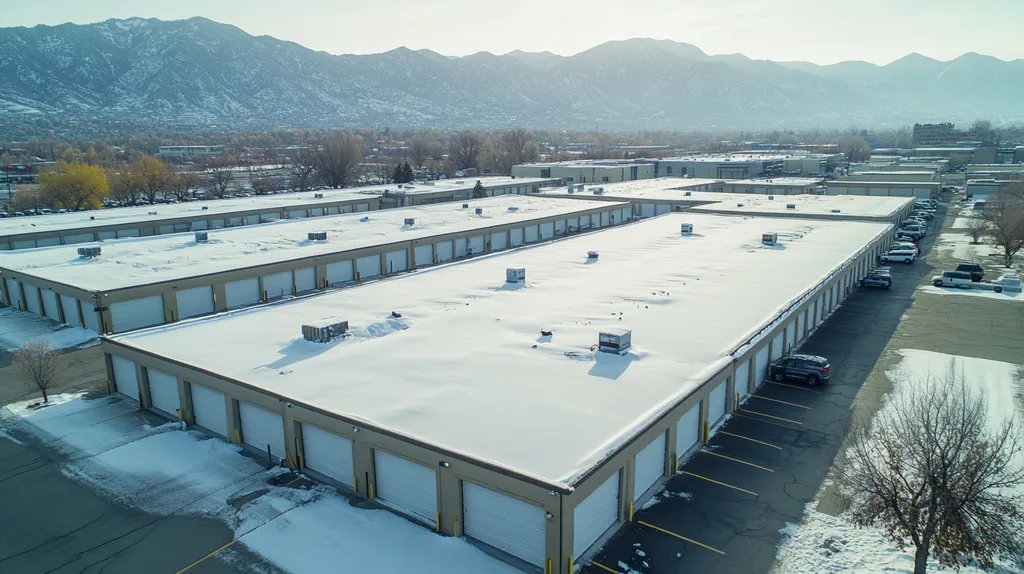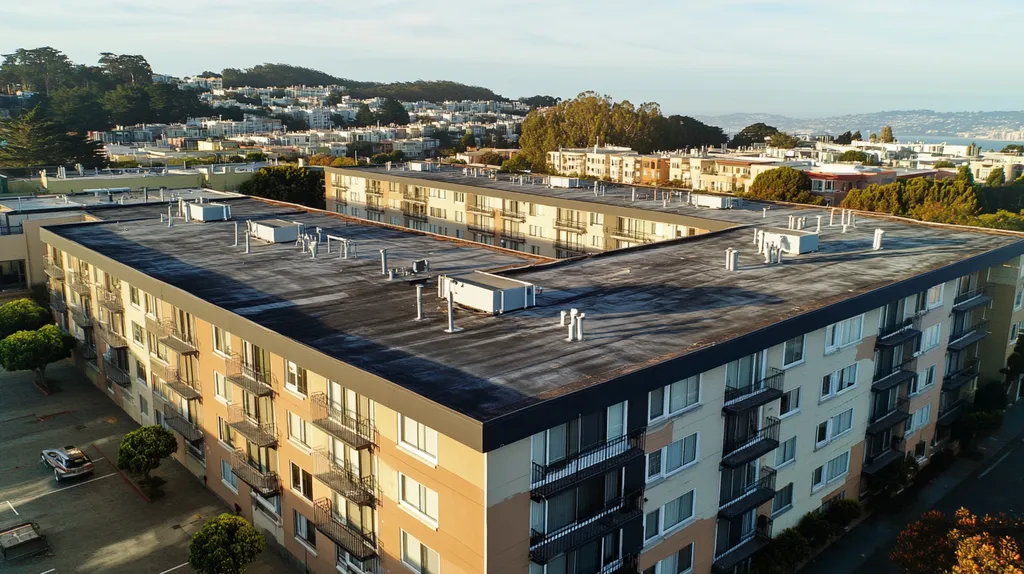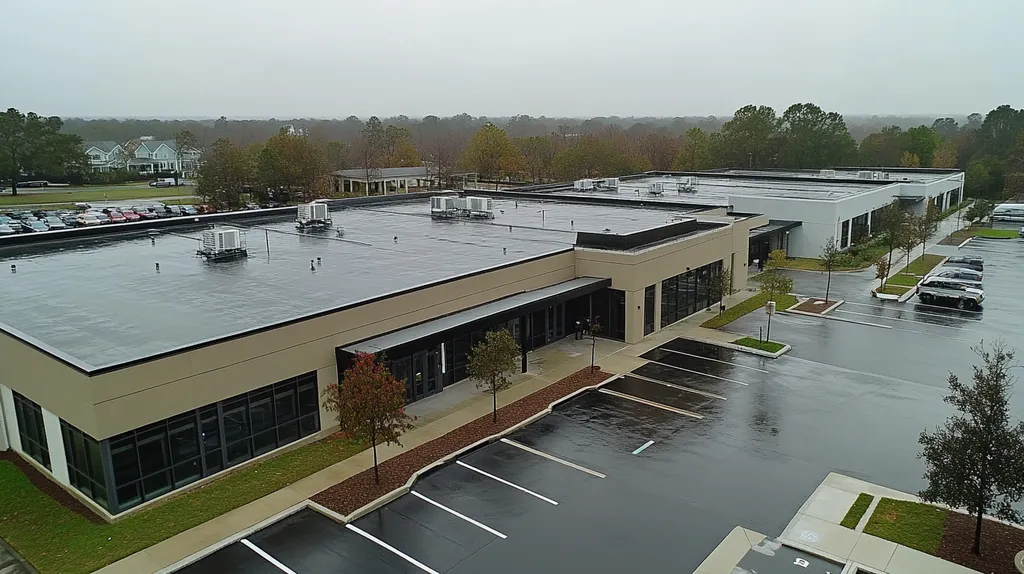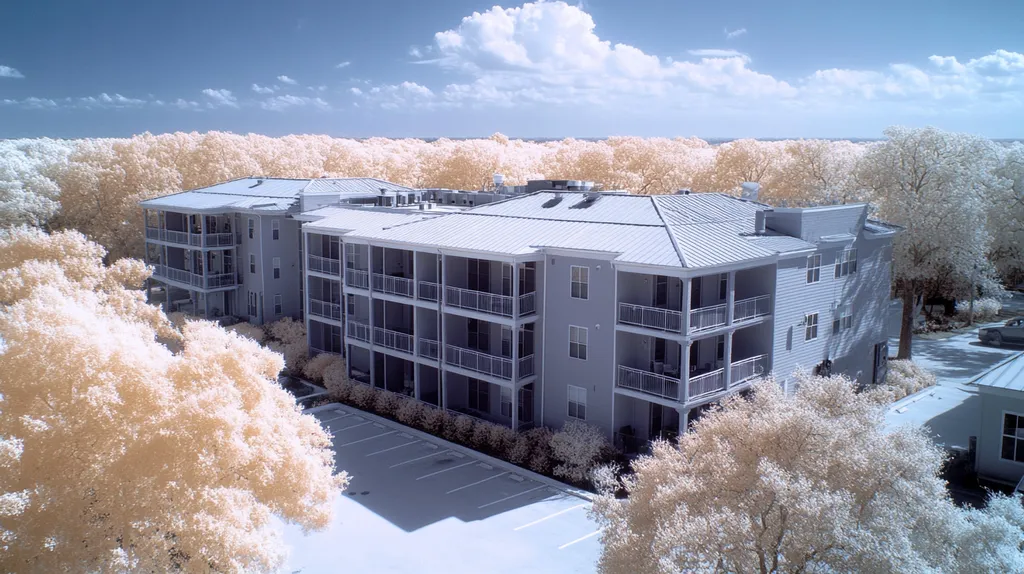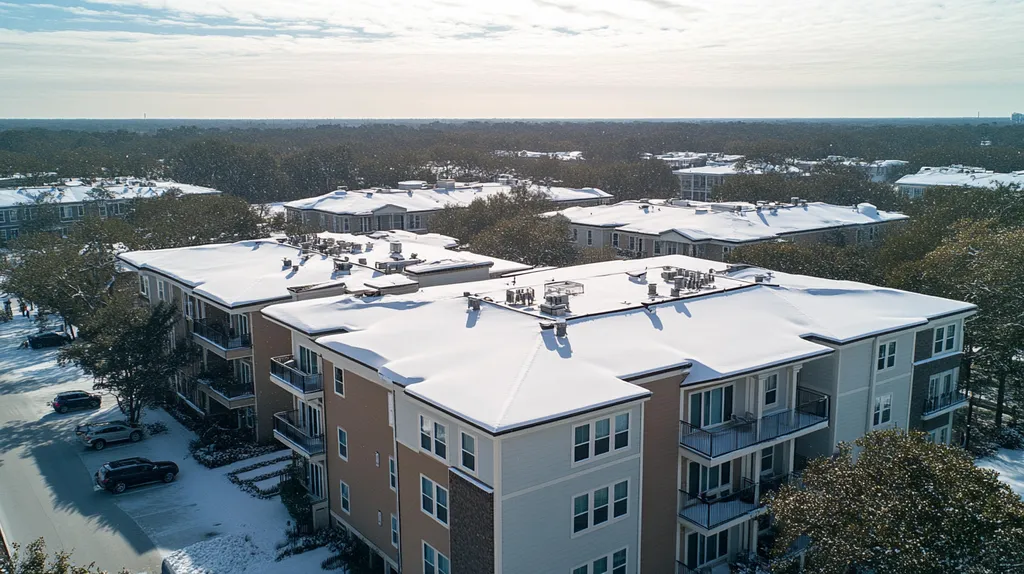Welcome to today’s Battle Royale featuring two roofing heavyweights: “Silicone” in the east corner versus “Polyurea” in the west!
Tonight’s showdown pits these contenders against each other across six punishing rounds designed to test every aspect of their performance for Commercial Roof Coatings.
At stake? Millions in potential costs, decades of building protection, and the critical performance demands of modern commercial and industrial facilities.
Our professional judging panel will evaluate each round on technical merit, real-world performance, and value delivery. After all six rounds, we’ll declare our ultimate champion.
Ladies and gentlemen, facility managers and building owners… it’s time to rumble!
ROUND 1: INITIAL COSTS & INSTALLATION
In the high-stakes world of commercial roofing, coating decisions can make or break your bottom line. With material costs skyrocketing and labor shortages plaguing the industry, choosing between silicone and polyurea isn’t just about performance – it’s about protecting your investment. Let’s break down the financial chess match between these coating heavyweights.
Material Expenses
Let’s cut through the marketing hype and talk real numbers. Silicone coatings command premium prices, typically $2-4 per square foot for materials alone. Their manufacturers love to justify this with fancy charts about UV resistance and weatherability.
Polyurea swoops in as the budget-friendly challenger, usually running $1-3 per square foot. But don’t pop the champagne just yet – these initial savings might need to be redirected into surface prep and primers.
While both options have their merits, polyurea’s lower entry point gives budget-conscious facility managers more flexibility. Even with extra prep materials, it still edges out silicone’s premium pricing.
Installation Complexity
Silicone installation is about as forgiving as a drill sergeant at boot camp. It demands pristine surfaces, perfect weather conditions, and precise application thickness. One mistake, and you’re looking at costly do-overs.
Polyurea, on the other hand, is more like that easy-going cousin who always lands on their feet. Its rapid cure time and forgiving nature mean fewer application headaches and less chance of contractor error.
The simpler installation process of polyurea means lower labor costs and fewer chances for expensive mistakes. This round goes decisively to polyurea for keeping things straightforward.
Project Timeline
Time is money, and silicone coatings seem to have missed that memo. With cure times measured in days and weather dependency that would make a meteorologist nervous, silicone projects can drag on longer than a government committee meeting.
Polyurea charges through projects like a caffeinated cheetah. Its rapid cure time – often measured in minutes rather than days – means crews can complete large areas in a single shift, sometimes returning the roof to service the same day.
When every hour of downtime costs your facility money, polyurea’s speed advantage becomes a knockout punch. For timeline efficiency, polyurea takes this category without breaking a sweat.
ROUND 1 WINNER: POLYUREA COATINGS
ROUND 2: DURABILITY & LIFESPAN
In the high-stakes arena of commercial roofing, coating durability isn’t just about longevity – it’s about protecting millions in assets and operations. Every day your roof fails to perform is another day of potential water damage, equipment failures, and business disruptions. With climate patterns becoming more extreme and maintenance budgets under constant pressure, choosing the right coating has never been more critical.
Durability Under Environmental Stress
Silicone coatings strut onto the durability stage like a weathered prize fighter, boasting unmatched UV resistance and flexibility that would make a yoga instructor jealous. Their ability to handle thermal cycling and maintain properties under intense sun exposure has made them the darling of sun-belt facilities.
Polyurea charges in with the subtlety of a bulldozer, bringing impact resistance that treats hail like confetti and chemical resistance that laughs at industrial pollutants. Its tensile strength and tear resistance make it the bouncer of the coating world, tossing aside physical abuse that would send other coatings crying home.
While silicone excels in UV stability, polyurea’s broader resistance profile and superior physical properties give it the edge in most real-world applications. For facilities facing multiple stress factors, polyurea takes the clear ADVANTAGE.
Longevity of Coating Performance
Silicone coatings promise the longevity of a tortoise – slow and steady, with typical lifespans of 10-15 years when properly maintained. Their gradual chalking process actually helps them self-clean, though it can make recoating more challenging down the road.
Polyurea swaggers in with projected lifespans exceeding 20 years, backed by molecular bonds that treat time like a mere suggestion. Its resistance to degradation means it maintains its physical properties longer, requiring less frequent touch-ups or repairs.
The math here isn’t complicated – polyurea’s superior longevity and stability translate to fewer replacement cycles and lower lifetime costs. This round shows another clear ADVANTAGE for polyurea.
Impact on ROI and Operational Efficiency
Let’s talk money – because at the end of the day, that’s what keeps the lights on. Silicone’s initial cost advantages can look appealing on paper, but factor in its shorter lifespan and more frequent recoating needs, and those savings start evaporating faster than roof moisture on a summer day.
Polyurea’s higher upfront investment pays dividends through extended performance periods and reduced maintenance requirements. Its rapid cure time also means less facility downtime during installation and repairs.
When you crunch the long-term numbers, polyurea’s superior durability and reduced maintenance needs deliver a more attractive ROI. The bean counters will love this – polyurea claims another ADVANTAGE.
ROUND 2 WINNER: POLYUREA COATINGS
ROUND 3: PERFORMANCE FACTORS
When your commercial roof fails, it’s not just about patching a leak – it’s about protecting millions in assets, equipment, and operations underneath. With extreme weather events increasing and maintenance budgets shrinking, choosing the wrong coating could turn your building into an impromptu indoor water park. Let’s dive into the performance metrics that separate the champions from the pretenders.
Weather Resistance
Mother Nature doesn’t care about your warranty claims or maintenance schedule. She’ll throw everything from acid rain to ice storms at your roof, and your coating better be ready for the fight.
Silicone struts onto the scene like a weatherproof superhero, with hydrophobic properties that make water bead up and roll off faster than a caffeinated jackrabbit. Its moisture resistance is legendary, laughing in the face of ponding water while maintaining flexibility in brutal temperature swings.
Polyurea tries to keep up but stumbles when the clouds open up. While it handles temperature changes like a champ, prolonged exposure to standing water can be its kryptonite, potentially leading to adhesion issues and premature aging.
For weather resistance, silicone claims a clear “ADVANTAGE” by keeping buildings dry when it matters most.
Impact Resistance
Commercial roofs take more abuse than a rental car at a demolition derby. From maintenance crews dropping tools to hailstorms that would make a golf ball jealous, impact resistance isn’t just a nice-to-have – it’s essential.
Silicone shows up wearing kid gloves, with impact resistance about as impressive as wet cardboard. Its softer nature means every dropped wrench and wayward branch becomes a potential puncture point.
Polyurea storms in wearing brass knuckles, shrugging off impacts that would send other coatings crying to their manufacturer. Its superior tensile strength and tear resistance make it the undisputed heavyweight champion of durability.
In this category, polyurea scores an easy “ADVANTAGE” by being tougher than a $2 steak.
UV Stability
The sun beats down on your roof like it’s got a personal vendetta, degrading materials faster than a toddler with fingerpaints. UV stability determines whether your coating will go the distance or fade away like last year’s fashion trends.
Silicone emerges as the sun’s worst nightmare, maintaining its properties while other coatings crumble under UV assault. Its molecular structure stays stable longer than a government bond, preserving both appearance and performance.
Polyurea starts strong but fades faster than a cheap t-shirt, with UV exposure leading to chalking and color changes that would make a chameleon dizzy. While it doesn’t immediately fail, its aesthetic degradation can be a deal-breaker for image-conscious facilities.
For UV stability, silicone claims another clear “ADVANTAGE” by keeping its cool under solar pressure.
ROUND 3 WINNER: SILICONE COATINGS
ROUND 4: MAINTENANCE REQUIREMENTS
When your roof coating fails, it’s not just an inconvenience – it’s a financial time bomb ticking away above your head. Every skipped inspection, delayed repair, or ignored warning sign brings you closer to catastrophic failure. With maintenance costs eating up to 30% of facility budgets, choosing between silicone and polyurea isn’t just about performance – it’s about protecting your sanity and your wallet.
Inspection Requirements
Regular inspections are the heartbeat of any coating system, combining traditional walk-throughs with cutting-edge drone technology and thermal imaging to spot trouble before it becomes a crisis. Comprehensive assessment methods help identify hidden damage sources and inform repair strategies for both coating types. (source: Structura View)
Silicone coatings bring a “set it and forget it” approach to inspections. Their self-cleaning surface and exceptional UV stability mean fewer surprise issues between scheduled checks, though ponding areas still need regular attention.
Polyurea demands more frequent scrutiny, especially around seams and penetrations. Its superior impact resistance doesn’t eliminate the need for regular damage checks, particularly in high-traffic areas or regions prone to severe weather.
When it comes to inspection demands, silicone claims a clear ADVANTAGE by requiring less frequent monitoring.
Repair Complexity
Silicone repairs are about as straightforward as roofing gets. Small patches blend seamlessly with existing coating, requiring minimal surface prep and no special primers or activators.
The material’s natural flexibility means repairs can handle building movement and thermal cycling without cracking or separating. Even better, silicone’s resistance to UV degradation means patch areas won’t stand out like a sore thumb.
Polyurea repairs feel like trying to solve a Rubik’s cube blindfolded. The rapid cure time that makes initial installation so attractive becomes a liability, demanding perfect timing and expert application to avoid cold joints or adhesion issues.
For keeping repairs simple and successful, silicone takes another clear ADVANTAGE.
Long-term Maintenance Costs
Silicone’s maintenance ledger reads like a minimalist’s shopping list. Annual cleaning, occasional recoating of high-wear areas, and spot repairs make up the bulk of ongoing expenses.
The coating’s natural chalking process actually helps maintain its protective properties, though it can make future recoating more challenging. However, this trade-off pays dividends through reduced cleaning requirements and extended service life.
Polyurea maintenance budgets look more like a novel than a shopping list. More frequent cleanings, specialized repair materials, and the need for expert application teams drive up long-term costs faster than a sports car with a lead foot.
In the battle of lifetime maintenance expenses, silicone scores yet another ADVANTAGE.
ROUND 4 WINNER: SILICONE COATINGS
ROUND 5: SUSTAINABILITY CREDENTIALS
In today’s climate-conscious market, roofing sustainability isn’t just about being green – it’s about staying competitive and compliant. With new environmental regulations dropping faster than rain in a thunderstorm and energy costs soaring higher than a contractor’s insurance premiums, choosing the right coating can mean the difference between leading the pack and playing catch-up.
Energy Efficiency
When summer hits, your roof becomes either your best friend or your worst enemy in the battle against cooling costs. The right coating can slash your HVAC expenses faster than an efficiency consultant with a red pen.
Silicone struts onto the energy stage like a solar-powered superhero, boasting reflectivity ratings that would make a mirror jealous. Its stable molecular structure maintains these properties longer than most building managers keep their jobs.
Polyurea stumbles here like a penguin in the desert. While it offers decent initial reflectivity, its tendency to degrade under UV exposure means those energy-saving properties fade faster than your building’s maintenance budget.
For keeping your energy bills lower than your stress levels, silicone claims a clear ADVANTAGE.
Environmental Footprint
Manufacturing impact hits harder than a sledgehammer on concrete, and today’s environmentally conscious tenants are asking tougher questions than ever. Smart property managers need answers that don’t sound like greenwashing.
Silicone brings clean credentials to the table, with VOC levels lower than a librarian’s whisper. Its production process creates minimal waste, and its durability means fewer replacement cycles clogging up landfills.
Polyurea crashes this eco-party like a gas-guzzler at an electric car show. Its production process involves more chemicals than a university lab, and its shorter lifespan means more frequent replacements.
For minimizing environmental impact while maximizing green credibility, silicone takes another clear ADVANTAGE.
Recyclability and End-of-Life
What happens to your coating when it’s time to say goodbye matters more than most realize. With landfill costs rising faster than Manhattan real estate, end-of-life considerations can’t be ignored.
Silicone keeps things simple at disposal time, with materials that can be recycled easier than sorting your office paper waste. Its inert nature means it won’t leave toxic surprises for future generations.
Polyurea makes disposal about as complicated as explaining quantum physics to a toddler. Its complex chemical structure means recycling options are limited, and separation from other materials can be a nightmare.
For making end-of-life management less painful than a root canal, silicone scores another clear ADVANTAGE.
ROUND 5 WINNER: SILICONE COATINGS
ROUND 6: SPECIALIZED APPLICATIONS
When your roof coating fails in a specialized application, it’s not just about repairs – it’s about catastrophic system failures that can shut down million-dollar operations. From food processing facilities where hygiene is paramount to chemical plants where corrosion never sleeps, choosing the wrong coating can transform a minor specification error into a major business disaster.
Chemical Resistance
In industrial environments, your roof coating faces more chemical exposure than a lab technician’s safety goggles. From airborne pollutants to process exhaust, every day brings new attacks on coating integrity.
Silicone shows up to this chemical fight wearing flip-flops, displaying weakness against solvents and petrochemicals that can turn it into goo faster than an industrial accident. Its susceptibility to chemical degradation makes it a risky choice for manufacturing facilities.
Polyurea struts in wearing a hazmat suit, shrugging off chemical exposure that would dissolve lesser coatings. Its superior chemical resistance and stability make it the champion of industrial applications.
For handling harsh chemical environments, polyurea claims a clear ADVANTAGE.
Temperature Extremes
Modern facilities push building materials to their limits, from freezer warehouses that rival the Arctic to process areas hotter than a blacksmith’s forge. Your coating needs to handle these extremes without cracking, peeling, or losing adhesion.
Silicone maintains flexibility across an impressive temperature range, handling thermal shock better than a penguin in a hot tub. Its stable molecular structure prevents brittleness in cold and softening in heat.
Polyurea starts strong but can become brittle in extreme cold and soften under intense heat. While it handles moderate temperature changes well, its performance at the extremes leaves facility managers sweating.
For managing temperature extremes, silicone takes a clear ADVANTAGE.
Specialized Compliance
In regulated environments like food processing, pharmaceutical manufacturing, and healthcare facilities, your coating choice can make or break compliance audits. Non-compliance isn’t just expensive – it can shut down operations faster than a health inspector at a dirty restaurant.
Silicone brings clean credentials and exceptional moisture resistance but can raise eyebrows in facilities where chemical resistance is critical. Its potential for degradation in certain environments can create contamination risks.
Polyurea delivers NSF certification and superior chemical resistance, making it the go-to choice for facilities where regulatory compliance determines survival. Its robust performance characteristics align perfectly with stringent industry requirements.
For maintaining specialized compliance, polyurea scores another clear ADVANTAGE.
ROUND 6 WINNER: POLYUREA
AND THE WINNER IS…
After six grueling rounds of technical analysis, testing both contenders to their absolute limits, we have our verdict!
With a score of 3 rounds to 3, this championship bout ends in a SPECTACULAR DRAW! Ladies and gentlemen, we’ve witnessed a true clash of titans where each coating proved its dominance in different arenas.
Polyurea dominated the early rounds with knockout performances in cost-effectiveness, durability, and specialized applications. Its rapid cure time, superior impact resistance, and chemical resistance make it the undisputed champion for industrial facilities and high-traffic environments.
Silicone proved unbeatable in weather resistance, maintenance simplicity, and sustainability. Its exceptional UV stability, minimal maintenance requirements, and impressive energy efficiency credentials make it the clear choice for sun-exposed roofs and environmentally conscious facilities.
But remember, folks – every building faces unique challenges. Local climate conditions, facility operations, and specific roof characteristics can dramatically impact coating performance. What delivers a knockout performance on one roof might stumble on another.
Before making your final decision, consult with qualified roofing professionals who can evaluate your specific situation. They’ll help ensure your choice is a perfect match for your facility’s unique requirements.
In the high-stakes arena of commercial roofing, victory doesn’t go to the strongest contender – it goes to the right contender for YOUR building’s specific battle!
FREQUENTLY ASKED QUESTIONS
Q. What are the costs of commercial roof coatings?
A. Silicone coatings typically range from $2-4 per square foot, while polyurea costs $1-3. While polyurea appears cheaper initially, the required surface prep can eat into those savings. Choosing the right coating impacts your budget, so consider both upfront and long-term costs.
Q. How durable are silicone and polyurea coatings for industrial roofs?
A. Silicone excels in UV resistance and flexibility, making it ideal for sunny environments. Polyurea, however, boasts superior impact and chemical resistance, allowing it to handle harsh conditions better than silicone. Depending on your facility’s specific needs, one may outperform the other in durability.
Q. Which coating performs better under extreme weather conditions for commercial roofs?
A. Silicone coatings shine in moisture resistance and flexibility, making them tough against rain and temperature swings. Polyurea handles temperature changes well but may struggle with standing water, impacting its longevity. For extreme weather, silicone often provides better overall performance.
Q. What are the maintenance requirements for commercial roof coatings?
A. Silicone coatings typically require less frequent inspections and maintenance due to their self-cleaning properties. In contrast, polyurea needs more regular checks, especially in high-traffic areas, which can increase overall maintenance costs. Assessing each coating’s demands is crucial for effective management.
Q. How do silicone and polyurea compare regarding sustainability in roof coatings?
A. Silicone coatings have lower VOC emissions and last longer, minimizing environmental impact. Polyurea, on the other hand, involves more chemicals in its production, leading to a larger ecological footprint. For environmentally conscious property managers, silicone usually emerges as the more sustainable choice.
Q. Which coating is more suitable for specialized applications in industrial roofs?
A. Polyurea is ideally suited for specialized applications due to its superior chemical resistance and robustness. It holds up well in environments exposed to harsh substances, unlike silicone, which can degrade more quickly under similar stress. Select polyurea for demanding industrial settings.
Q. What should property managers consider when selecting a roof coating?
A. Property managers should evaluate cost, durability, maintenance needs, and environmental impact when choosing a roof coating. Consider how extreme weather or specialized applications may affect performance. Proper research into these factors will ensure optimal investment for your commercial roof.

